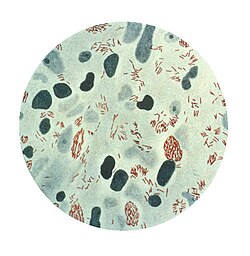Mycobacterium leprae
Mycobacterium leprae is a bacteria. It causes the disease, leprosy, also known as the Hanson's Disease.
| Mycobacterium leprae | |
|---|---|

| |
| Microphotograph of Mycobacterium leprae taken from a skin lesion | |
| Scientific classification | |
| Kingdom: | |
| Phylum: | |
| Order: | |
| Suborder: | |
| Family: | |
| Genus: | |
| Binomial name | |
| Mycobacterium leprae Hansen, 1874
| |
Discovery
The bacterium was discovered in 1873 by a Norwegian doctor named Gerhard Armauer Hansen. M. leprae is a gram-positive, aerobic rod surrounded by the characteristic waxy coating unique to Mycobacteria.
Features
In size and shape, it closely resembles M. tuberculosis. Due to its thick, waxy coating, stains with carbol-fuchsin are used, rather than with the traditional Gram staining method.
+{{{1}}}−{{{2}}}
Mycobacterium Leprae Media
Chemical structure of Dapsone, the first effective antibiotic for the treatment of leprosy, discovered in the 1940s
Gerhard Armauer Hansen (1841–1912), who first discovered Mycobacterium leprae in 1873



